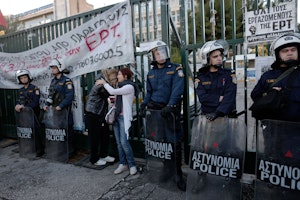Does Digital Media Mean Better Media?
By Marius Dragomir
Back in 2005, we launched Television Across Europe, a study that examined the state of broadcast regulation in 20 countries, mostly in Eastern Europe, in an attempt to nail down problems in the way broadcast media was regulated and to recommend ways to improve the regulatory environment in which journalists and media operated.
The findings were rather grim. Pressures on journalists from mighty owners, ailing public service broadcasters, and politicized regulators were making the work of journalists in this region a painful enterprise.
Around that time, many researchers and activists from civil society were turning their attention to digital television. Regulators were already looking into letting a new wave of broadcasters set up operations, and governments were starting to concoct strategies on digital communications. The transition could offer new opportunities—or reinforce old power structures.
In 2007 we began work on a new study to analyze what digital broadcasting would mean for journalists and citizens at large. Originally, the idea was to map the opportunities and risks that digital television would bring in a number of European countries.
Following lengthy consultations with experts, we realized what an intricate process the migration to digital television was. The technical part of it was daunting. When we looked at a graph that one of the consultants sent us in an attempt to explain transmission of digital broadcasting, we hardly knew where to start. It was all arrows, acronyms, and technical lingo.
The more we looked into it, the bigger the study’s scope became. Following a year of methodological discussions and consultations, we embarked on Mapping Digital Media, a comparative study that covered not only digital broadcasting but also the internet, and that expanded from a European project into a global one spanning 60 countries on all continents, ranging from Montenegro to Nicaragua to China to Egypt.
Would journalists have better ways to access and gather information? Would people have improved access to good-quality journalistic content? This is the story we wanted to tell.
In April 2011, the first report in the project, on Romania, was published. Three years later, the last report, on Indonesia, marked the end of the project. Lack of data and poor access to information coupled with scarce research capacity were to blame for not finalizing reports in six nations, most of them in the former Soviet Union.
But over the course of these years, calls to join the project came from Vietnam, Bolivia, Australia, Cuba, Cambodia, Canada, and Finland. Two of those materialized, and eventually 56 country reports comprising a total of 5,575 pages of analysis came out.
Authored by 182 local researchers with extensive backgrounds and expertise, the reports have generated innumerable citations in documents and policy papers issued by global and local intergovernmental organizations, governments, and regulators, and have become part of the curricula in universities across the world.
But beyond the written word, what really matters is the impact of this project in real life. Words like “advocacy” flummoxed some of the researchers engaged in this work as they had expected it to end up on library shelves, not in policymakers’ hands. As all the research was carried out in English, a total of 32 reports have been translated in local languages to make this work accessible to local policymakers and other audiences.
Overall, this part of the work has been equally rewarding and frustrating. While some uncooperative governments dashed any attempts at dialog, in a number of countries as diverse as Pakistan, Armenia, China, Kazakhstan or Morocco, the project generated fresh debates on media reform. Over 300 recommendations were drafted by local experts in this project and roundtables that debated these proposals have taken place in almost 40 countries.
Mexico has likely been the biggest victory in this project to date. A local, well-connected organization, the Mexican Association of the Right to Information, launched the Mexico report in eight states and called on politicians to take on board its recommendations. Following a year of advocacy work, a total of 19 of the 21 recommendations in the report made it into the legislation adopted by the Congress in June 2013.
This should mean in the future more access to frequencies for community media, a stronger public service media system, and increased diversity in the media. In a country where two broadcasters control some 94 percent of the broadcast airwaves, all these are groundbreaking changes.
In a separate case, concerns raised in the report on Italy prompted the European Commission in the fall of 2012 to send a stern response to the Italian regulator AGCOM requiring them to ensure fairness in licensing new broadcasters in Italy. In spring last year, under pressure from the commission, approved amended rules that made room for new entrants and limited the expansion of the three dominant incumbents, public RAI and private Mediaset and Telecom Italia.
The Mapping Digital Media research is completed, but the work on the ground doesn’t stop here. Over 20 groups in the field are running advocacy initiatives inspired by this project and various research organizations took on their own to update the reports and generate new projects.
In one of the biggest such undertakings, a newly set up organization spawned by the Mapping Digital Media project is creating a Latin American observatory to monitor public policy on digitization in nine countries in the region. In Romania, a year before analog television is to be turned off, a local journalism organization works to ensure that a swath of digital frequencies up for grabs are to be awarded in a transparent and fair manner. The work of all these groups is likely to have an impact on media reform for years to come.
Until August 2016, Marius Dragomir was senior manager and publications editor with the Open Society Program on Independent Journalism.
